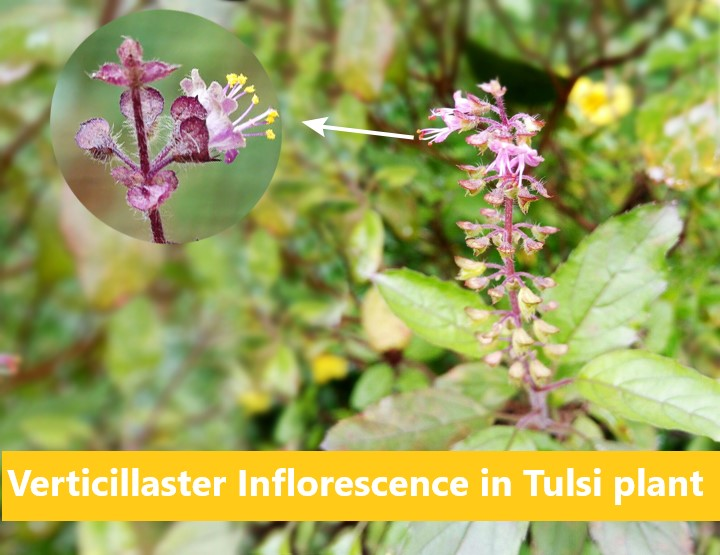
In Tulsi(Ocimum) of Labiate, the inflorescence is
(a)Cyathium
(b)Verticillsater
(c)Hypanthodium
(d)Raceme of racemose
Answer
483.9k+ views
Hint: The manner in which the flowers are arranged as well as distributed over a plant is known as inflorescence. The arrangement occurs on a peduncle which is the axis of inflorescence.
Complete answer:
The inflorescence, in general, is of four main types- Racemose inflorescence the main axis does not end in a single flower instead it grows continuously. Cymose inflorescence, wherein the peduncle or the main axis ends in a single flower, therefore only a definite or determinate number of flowers are formed. Mixed inflorescence, where two or more types of inflorescence get mixed up and some special types of inflorescence. Tulsi(Ocimum) of Labiate exhibits Verticillsater inflorescence which is a special type of inflorescence.
Additional Information:
Cymose is further subdivided into the following types:
Uniparous or Monochasial Cyme: After a terminal bud of the main axis has ended into a flower, a single lateral branch develops which again bears a terminal bud and a lateral branch and so on. This process may be continued in a helical manner or scorpioid manner.
Biparous or Dichasial Cyme: The main axis terminates into a flower and two lateral branches. The process is repeated with these branches. They themselves terminate into a flower but not without giving off two lateral branches and so on.
Tulsi(Ocimum) of Labiate exhibits mixed inflorescence. Two clusters of condensed cymose inflorescence with sessile flowers or extremely short-stalked flowers exist in the axils of opposite leaves. Each cluster or whorl bears 3-9 flowers. Axil is the area between the leaf and upper part of the stem. Each inflorescence is initially a dichasial cyme but its branches are monochasial cyme. Both the clusters of inflorescence often give a false impression of a single whorl due to overcrowding.

So, the correct answer is ‘Verticillaster'.
Note: An important medicinal plant family Labiate or Lamiaceae exhibits verticillaster inflorescence of which Tulsi, mints, spearmint are members. They are usually small herbs or shrubs with aromatic smell and cultivated for various purposes- ornamental, perfumery, medicinal, and culinary being some of them. Tulsi has been a sacred plant grown in the Indian household for centuries. It has been described as a healing herb in Hindu traditions. It is an important contributor in Ayurvedic medicines. Its medicinal properties include anti-allergic, anti-microbial, and anti-diabetic.
Complete answer:
The inflorescence, in general, is of four main types- Racemose inflorescence the main axis does not end in a single flower instead it grows continuously. Cymose inflorescence, wherein the peduncle or the main axis ends in a single flower, therefore only a definite or determinate number of flowers are formed. Mixed inflorescence, where two or more types of inflorescence get mixed up and some special types of inflorescence. Tulsi(Ocimum) of Labiate exhibits Verticillsater inflorescence which is a special type of inflorescence.
Additional Information:
Cymose is further subdivided into the following types:
Uniparous or Monochasial Cyme: After a terminal bud of the main axis has ended into a flower, a single lateral branch develops which again bears a terminal bud and a lateral branch and so on. This process may be continued in a helical manner or scorpioid manner.
Biparous or Dichasial Cyme: The main axis terminates into a flower and two lateral branches. The process is repeated with these branches. They themselves terminate into a flower but not without giving off two lateral branches and so on.
Tulsi(Ocimum) of Labiate exhibits mixed inflorescence. Two clusters of condensed cymose inflorescence with sessile flowers or extremely short-stalked flowers exist in the axils of opposite leaves. Each cluster or whorl bears 3-9 flowers. Axil is the area between the leaf and upper part of the stem. Each inflorescence is initially a dichasial cyme but its branches are monochasial cyme. Both the clusters of inflorescence often give a false impression of a single whorl due to overcrowding.

So, the correct answer is ‘Verticillaster'.
Note: An important medicinal plant family Labiate or Lamiaceae exhibits verticillaster inflorescence of which Tulsi, mints, spearmint are members. They are usually small herbs or shrubs with aromatic smell and cultivated for various purposes- ornamental, perfumery, medicinal, and culinary being some of them. Tulsi has been a sacred plant grown in the Indian household for centuries. It has been described as a healing herb in Hindu traditions. It is an important contributor in Ayurvedic medicines. Its medicinal properties include anti-allergic, anti-microbial, and anti-diabetic.
Recently Updated Pages
Master Class 11 Accountancy: Engaging Questions & Answers for Success

Glucose when reduced with HI and red Phosphorus gives class 11 chemistry CBSE

The highest possible oxidation states of Uranium and class 11 chemistry CBSE

Find the value of x if the mode of the following data class 11 maths CBSE

Which of the following can be used in the Friedel Crafts class 11 chemistry CBSE

A sphere of mass 40 kg is attracted by a second sphere class 11 physics CBSE

Trending doubts
10 examples of friction in our daily life

Difference Between Prokaryotic Cells and Eukaryotic Cells

State and prove Bernoullis theorem class 11 physics CBSE

What organs are located on the left side of your body class 11 biology CBSE

Define least count of vernier callipers How do you class 11 physics CBSE

The combining capacity of an element is known as i class 11 chemistry CBSE




